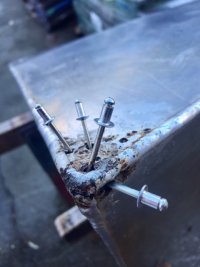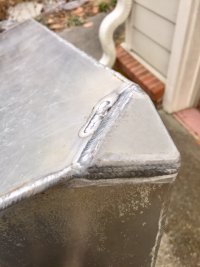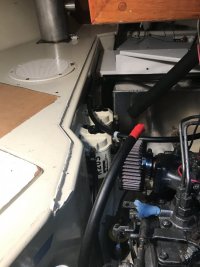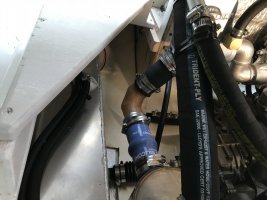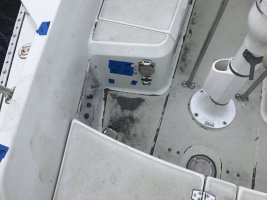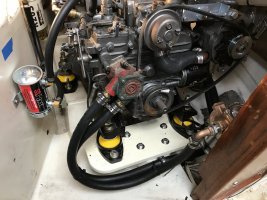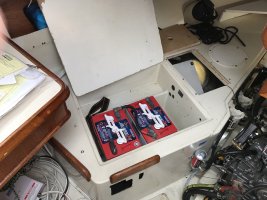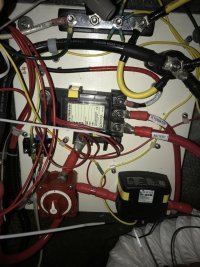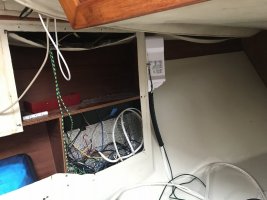You are using an out of date browser. It may not display this or other websites correctly.
You should upgrade or use an alternative browser.
You should upgrade or use an alternative browser.
Ericson 30+ Fuel Tank Replacement
- Thread starter Dave G.
- Start date
Dave G.
1984 E30+ (SOLD)
Yeah that would be a plan. I already pulled out the refrigeration unit that sat right next to the WH. They obviously installed tank and water heater before the engine as that is the only way to get anything out and back in. That plywood board is glassed to the hull on both ends so i am wondering if it is somehow structural. I'll have remove the water heater and won't be replacing it so that will help access to the whole area. Shaft, trans, steering. The quarter berth is nice on a small boat but the cost is reasonable access to aging systems. I'll be long gone in 30 years so 8-10 is good for me.
Yup - that's where they seem to leak. It's the low-point in the tank (which is why the fuel pump and fill-level gauge are above that corner), and it's where any condensation outside the tank or other water sources would pool and start corroding the tank from the outside. Then, when a pinhole eventually forms, the water-diesel sludge continues the attack. Here's what ~35 years lead to in my case - before and after surgery:Mark, I went to the boat today and drained all the fuel out and saw a little corrosion in the front seem just below the fuel pickup. I only had the fuel gauge sender hole to look through so will have to cut a larger hole and get a camera to look at the whole tank. I have a question for you, did you see the pics that bigd posted above of his aft compartment above the tank ? As your boat is older than mine by a year I am curious if yours has a complete floor and liner ?
Attachments
Dave G.
1984 E30+ (SOLD)
I wish I could get the tank our for inspection and repair but it would require major surgery and or engine removal. Those are some gaping holes, was the rest of the tank in good condition ?Yup - that's where they seem to leak. It's the low-point in the tank (which is why the fuel pump and fill-level gauge are above that corner), and it's where any condensation outside the tank or other water sources would pool and start corroding the tank from the outside. Then, when a pinhole eventually forms, the water-diesel sludge continues the attack. Here's what ~35 years lead to in my case - before and after surgery:
eknebel
Member III
Mine looks like yours, Dave. I used the access plate because i wasn't ready to remove everything back there, so went the quickest repair to save the season (still not leaking for 10 years). i used a boroscope to inspect the rest of the interior as best i could, focusing on the bases of the baffles. No other visible corrosion. After glassing in the repair, I performed a 1 hour pressure test at 3psi, with no loss using a quality digital psi meter.Frank, BigD, Ed, Mark,
Here are a couple of photos I took today. As you will see my boat is much more "primitive" than the photos you posted. More like the bowels of a JBoat.....I drained the fuel through the fuel gauge/sender plate shown in second pic.
I would be surprised if the tank would fit thru port lazarette without removing trash can shelf and galley organizer. YMMV, but my wife loves the hot water, even if just for dishes. Showers can't be described as a pleasurable experience in such a cramped head, but they seem refreshingly worth it once over.
Last edited:
Yes - the rest of the tank was great.I wish I could get the tank our for inspection and repair but it would require major surgery and or engine removal. Those are some gaping holes, was the rest of the tank in good condition ?
I installed a couple of Seabuilt inspection ports for easy clean-out on both side of the internal baffle before the tank went back in, and for possible future inspection or cleaning: http://www.seabuilt.com/plates.php
You can cut the required hole easily with a jigsaw (and a steady hand to make the hole 'circular').
Dave G.
1984 E30+ (SOLD)
Thanks Ed, No it will not come out the lazarette for sure. I have pretty much decided to attempt a similar in place repair to what you did. even the WH will have to be cut to remove through lazarette. My wife is never going to shower on the boat & I live on a freshwater lake so that will work for bathing when needed. Ed do you think that plywood board over the tank is in any way structural ? I'm guessing that when they did the design changes in 84 to the cabin top traveler and cockpit configuration they went to that floor and liner beck there.Mine looks like yours, Dave. I used the access plate because i wasn't ready to remove everything back there, so went the quickest repair to save the season (still not leaking for 10 years). i used a boroscope to inspect the rest of the interior as best i could, focusing on the bases of the baffles. No other visible corrosion. After glassing in the repair, I performed a 1 hour pressure test at 3psi, with no loss using a quality digital psi meter.
I would be surprised if the tank would fit thru port lazarette without removing trash can shelf and galley organizer. YMMV, but my wife loves the hot water, even if just for dishes. Showers can't be described as a pleasurable experience in such a cramped head, but they seem refreshingly worth it once over.
eknebel
Member III
I don't think the shelf is structural as far as stiffening the hull, but it does keep you from stepping, kneeling, resting on the tank when you are accessing that area. The tank isn't fragile, but flexing aluminum over time may lead to stress cracks. I was thinking when I do the rehab in that area to glass mounts onto the hull with nuts and bolts that would secure the shelf, but would allow for removal of the shelf without having to re-glass it to the hull.
i took pictures before and after repair, which i will try to find...
i took pictures before and after repair, which i will try to find...
Last edited:
Dave G.
1984 E30+ (SOLD)
My leak started after I spent a few hours squatting, laying, sitting on that board to get my shaft loose from the coupler. I'm sure I just put the final stress on a corroded & weakened seem. It isn't stiff enough to protect the tank and mine had the refrigeration unit mounted there to. So with the WH and compressor unit there is a 100+ pounds bouncing up and down on the fuel tank for 36 yrs. I like the idea of removable shelf. maybe just cut it off just inside the tabbing glass and bolt a stiffer board to stubs.
Dave, to answer your earlier question about the quarterberth access, I just marked it close to the top to leave some meat to put a batten in on the backside to hold the cut panel. To cut it I screwed in a straightedge to guide the circular saw (and covered the engine with a sheet first!). There is a little piece that fits into the floor of the quarterberth that I screwed onto the panel. The whole thing is held in place with a few wood screws and lifts out as a unit. I really can't emphasize how useful this mod is, and I am surprised that Ericson did not include this feature as standard. Other models of the era (32-3 for example) have a removable panel in the quarterberth. When I first got the boat, I literally could not reach the shaft seal. Neither could the surveyor which is why the terrible decay in the shaft seal wasn't noticed. Even the diesel mechanic who was about 5'4" and 140 pounds said it was one of the worst he had seen!
The short panel over the tank is definitely different than mine. On my boat there is a groove molded into the fiberglass on both sides just above the level of the fuel tank that accepts the panel edges for a flush fit. It's hard to see in your pics whether a similar groove exists, but it sounds like not. Either way a full length panel over the tank in thicker material will allow access to the back of the boat for working on the quadrant, cockpit drains, electrical, etc.
We have discussed in other threads the possiblity of a transition period between the 30+ models. I have the cabin top traveller and the cockpit seats are beveled, which I believe is the most current version of the 30+. Yours may have had some elements of the current version and some of the old. Do you have the beveled seats in the cockpit? If so I wonder if they used the new deck mold and the old hull mold in your boat.
Couple more photos attached of the back of the boat and the cockpit to compare models. I have other photos of the stern when it was empty but they are on a hard drive I don't have access to right now. Will try to find them soon.
The short panel over the tank is definitely different than mine. On my boat there is a groove molded into the fiberglass on both sides just above the level of the fuel tank that accepts the panel edges for a flush fit. It's hard to see in your pics whether a similar groove exists, but it sounds like not. Either way a full length panel over the tank in thicker material will allow access to the back of the boat for working on the quadrant, cockpit drains, electrical, etc.
We have discussed in other threads the possiblity of a transition period between the 30+ models. I have the cabin top traveller and the cockpit seats are beveled, which I believe is the most current version of the 30+. Yours may have had some elements of the current version and some of the old. Do you have the beveled seats in the cockpit? If so I wonder if they used the new deck mold and the old hull mold in your boat.
Couple more photos attached of the back of the boat and the cockpit to compare models. I have other photos of the stern when it was empty but they are on a hard drive I don't have access to right now. Will try to find them soon.
Attachments
eknebel
Member III
I am convinced to add a access panel, since a new bracket for the Transmission shift cable is in my near future, thanks for the encouragement!Dave, to answer your earlier question about the quarterberth access, I just marked it close to the top to leave some meat to put a batten in on the backside to hold the cut panel. To cut it I screwed in a straightedge to guide the circular saw (and covered the engine with a sheet first!). There is a little piece that fits into the floor of the quarterberth that I screwed onto the panel. The whole thing is held in place with a few wood screws and lifts out as a unit. I really can't emphasize how useful this mod is, and I am surprised that Ericson did not include this feature as standard. Other models of the era (32-3 for example) have a removable panel in the quarterberth. When I first got the boat, I literally could not reach the shaft seal. Neither could the surveyor which is why the terrible decay in the shaft seal wasn't noticed. Even the diesel mechanic who was about 5'4" and 140 pounds said it was one of the worst he had seen!
The short panel over the tank is definitely different than mine. On my boat there is a groove molded into the fiberglass on both sides just above the level of the fuel tank that accepts the panel edges for a flush fit. It's hard to see in your pics whether a similar groove exists, but it sounds like not. Either way a full length panel over the tank in thicker material will allow access to the back of the boat for working on the quadrant, cockpit drains, electrical, etc.
We have discussed in other threads the possiblity of a transition period between the 30+ models. I have the cabin top traveller and the cockpit seats are beveled, which I believe is the most current version of the 30+. Yours may have had some elements of the current version and some of the old. Do you have the beveled seats in the cockpit? If so I wonder if they used the new deck mold and the old hull mold in your boat.
Couple more photos attached of the back of the boat and the cockpit to compare models. I have other photos of the stern when it was empty but they are on a hard drive I don't have access to right now. Will try to find them soon.
Dave G.
1984 E30+ (SOLD)
My cockpit seats are not beveled and traveler is on the bridge deck. It looks like the transition happened somewhere between my hull and Frank Langer's as his is #637 only 5 after mine. Your boat also looks to have a hull liner which mine does not so no I do not have a groove for the floor. That whole area is open to the hull and that shelf is glassed to it. The access to shaft and back of engine/trans is ridiculous. It's like no one even thought about it. I guess they just figured you should buy a new boat when the shaft started leaking or you need to align anything. I think the bulkhead cut out is the answer, I just need to move a lot of stuff to do that.Dave, to answer your earlier question about the quarterberth access, I just marked it close to the top to leave some meat to put a batten in on the backside to hold the cut panel. To cut it I screwed in a straightedge to guide the circular saw (and covered the engine with a sheet first!). There is a little piece that fits into the floor of the quarterberth that I screwed onto the panel. The whole thing is held in place with a few wood screws and lifts out as a unit. I really can't emphasize how useful this mod is, and I am surprised that Ericson did not include this feature as standard. Other models of the era (32-3 for example) have a removable panel in the quarterberth. When I first got the boat, I literally could not reach the shaft seal. Neither could the surveyor which is why the terrible decay in the shaft seal wasn't noticed. Even the diesel mechanic who was about 5'4" and 140 pounds said it was one of the worst he had seen!
The short panel over the tank is definitely different than mine. On my boat there is a groove molded into the fiberglass on both sides just above the level of the fuel tank that accepts the panel edges for a flush fit. It's hard to see in your pics whether a similar groove exists, but it sounds like not. Either way a full length panel over the tank in thicker material will allow access to the back of the boat for working on the quadrant, cockpit drains, electrical, etc.
We have discussed in other threads the possiblity of a transition period between the 30+ models. I have the cabin top traveller and the cockpit seats are beveled, which I believe is the most current version of the 30+. Yours may have had some elements of the current version and some of the old. Do you have the beveled seats in the cockpit? If so I wonder if they used the new deck mold and the old hull mold in your boat.
Couple more photos attached of the back of the boat and the cockpit to compare models. I have other photos of the stern when it was empty but they are on a hard drive I don't have access to right now. Will try to find them soon.
Dave G.
1984 E30+ (SOLD)
Also from my research here on the site I think the keel bolts are different on the 30+ 2nd Gen. Not sure if the keel/hull joint is different but would like to find out. Are there any X Ericson Yacht folks on this sight that may shed light on exactly when and why they made the changes ?My cockpit seats are not beveled and traveler is on the bridge deck. It looks like the transition happened somewhere between my hull and Frank Langer's as his is #637 only 5 after mine. Your boat also looks to have a hull liner which mine does not so no I do not have a groove for the floor. That whole area is open to the hull and that shelf is glassed to it. The access to shaft and back of engine/trans is ridiculous. It's like no one even thought about it. I guess they just figured you should buy a new boat when the shaft started leaking or you need to align anything. I think the bulkhead cut out is the answer, I just need to move a lot of stuff to do that.
Dave/Loren,
Discovery (1983 E-30+) has the same fuel tank location and construction. I removed the water tank the first year I owed her because is was completely rusted out and leaking. That left "plenty" of room to lay flat on the plywood. The tank is tabbed and glassed.
Mark "Souleman' Soule
Discovery (1983 E-30+) has the same fuel tank location and construction. I removed the water tank the first year I owed her because is was completely rusted out and leaking. That left "plenty" of room to lay flat on the plywood. The tank is tabbed and glassed.
Mark "Souleman' Soule
So you definitely have the 1st generation model. Knowing that, I would advise you check that quarterberth bulkhead to make sure it is not structural. In mine, the bulkhead was clearly hanging from the underside of the cockpit, rather than supporting it and it was not attached to anything at the bottom. It could very well be the same on your boat but I would hate for you to cut it out and find out it was actually supporting the cockpit!
Good luck and keep us up to date on your progress. I was extremely happy to get that whole rat nest of poorly run wiring, hoses and water heater, etc. under there cleaned out and fixed up. Ericson didn't seem to be too concerned with how things looked under there, but I guess it lasted 30 years so who can argue with their logic.
Good luck and keep us up to date on your progress. I was extremely happy to get that whole rat nest of poorly run wiring, hoses and water heater, etc. under there cleaned out and fixed up. Ericson didn't seem to be too concerned with how things looked under there, but I guess it lasted 30 years so who can argue with their logic.
Frank Langer
1984 Ericson 30+, Nanaimo, BC
We need Seth to chime in on this, as he was the sales manager, or similar position, with Ericson yachts. He would know when changes were made and perhaps the rationale behind them. He has been very helpful here in the past.
Frank
Frank
Dave G.
1984 E30+ (SOLD)
Was Seth there in the early/mid 80's ?We need Seth to chime in on this, as he was the sales manager, or similar position, with Ericson yachts. He would know when changes were made and perhaps the rationale behind them. He has been very helpful here in the past.
Frank
Dave G.
1984 E30+ (SOLD)
In your pics above what is that wood hatch and grille like cover in your quarter berth ?So you definitely have the 1st generation model. Knowing that, I would advise you check that quarterberth bulkhead to make sure it is not structural. In mine, the bulkhead was clearly hanging from the underside of the cockpit, rather than supporting it and it was not attached to anything at the bottom. It could very well be the same on your boat but I would hate for you to cut it out and find out it was actually supporting the cockpit!
Good luck and keep us up to date on your progress. I was extremely happy to get that whole rat nest of poorly run wiring, hoses and water heater, etc. under there cleaned out and fixed up. Ericson didn't seem to be too concerned with how things looked under there, but I guess it lasted 30 years so who can argue with their logic.
Frank Langer
1984 Ericson 30+, Nanaimo, BC
I can't recall when he left Ericson, but he knows alot about these boats.Was Seth there in the early/mid 80's ?
Frank
There are a couple factory circular screw in hatches in the quarterberth around the battery box and an aftermarket hatch that someone cut in there. The refrigeration unit and battery charger had been stuffed into this area with a bunch of foam padding but totally unsecured. It was a disaster waiting to happen. I ripped all that out and relocated the battery charger above the aft side of the quarterberth storage cabinet and the refrigerator to the bottom of the trash receptacle in the lazarette (shortened it and put a smaller trash can in).
I then installed all the wiring on a panel glassed into the hull under the aftermarket hatch. You can see the panel in the first photo and the wiring that was eventually installed in the second. And the charger location in the third.
I then installed all the wiring on a panel glassed into the hull under the aftermarket hatch. You can see the panel in the first photo and the wiring that was eventually installed in the second. And the charger location in the third.

